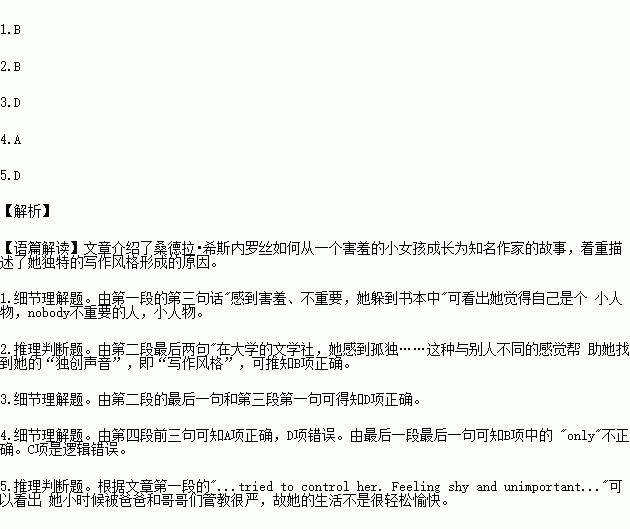题目内容
B
Sandra Cisneros was born in Chicago in 1954 to a Mexican American family. As the only girl in a family of seven children, she often felt like she had "seven fathers ", because her six brothers, as well as her father, tried to control her. Feeling shy and unimportant, she hid herself into books. Despite her love of reading, she did not do well in elementary school because she was too shy to participate.
In high school, with the encouragement of one particular teacher, Cisneros improved her grades and worked for the school literary magazine. Her father encouraged her to go to college because he thought it would be a good way for her to find a husband. Cisneros did attend college, but instead of searching for a husband, she found a teacher who helped her join the famous graduate writing program at the University of Iowa. At the University's Writers' Workshop, however, she felt lonely—a Mexican American from a poor neighborhood among students from wealthy families. The feeling of being so different helped Cisneros find her "creative voice".
"It was not until this moment when I considered myself truly different that my writing acquired a voice. I knew I was a Mexican woman, but I didn't think it had anything to do with why I felt so much imbalanced in my life, but it had everything to do with it! That's when I decided I would write about something my classmates couldn't write about."
Cisneros published her first work, The House on Mango Street , when she was twenty-nine. The book tells about a young Mexican American girl growing up in a Spanish-speaking area in Chicago, much like the neighborhoods in which Cisneros lived as a child. The book won an award in 1985 and has been used in classes from high school through graduate school level. Since then, Cisneros has published several books of poetry, a children's book, and a shortstory collection.
1.Which of the following is TRUE about Cisneros in her childhood?
A. She had seven brothers. B. She felt herself a nobody.
C. She was too shy to go to school. D. She did not have any good teachers.
2.The graduate program gave Cisneros a chance to
A. make a lot of friends B. develop her writing style
C. run away from her family D. work for a school magazine
3.According to Cisneros, what played the decisive role in her success?
A. Her early years in college. B. Her childhood experience.
C. Her training in the Workshop. D. Her feeling of being different.
4.What do we learn about The House on Mango Street ?
A. It is quite popular among students.
B. It is the only book ever written by Cisneros.
C. It wasn't a success as it was written in Spanish.
D. It won an award when Cisneros was twenty-nine.
5. According to the text, we know that________
A. she didn't enjoy reading
B. she met a Mexican American girl
C. her brothers treated her very kindly
D. she lived an uneasy life in her childhood

